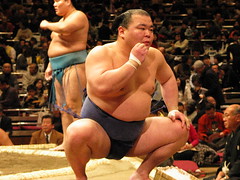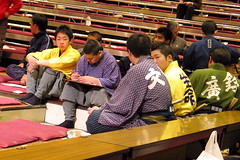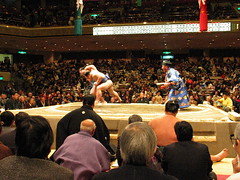The Sekitori Fights

After we left the wrestlers' changing room, Miki took me into the press club office, the walls of which were stained yellow. In an earlier time, before smoking was banned in the entire Kokugikan, only the most devoted chain smokers probably dared enter. Dark smudges spotted the yellow surface and the place smelled like old sesame oil, as though decades of Chinese takeout had permeated the atmosphere.
Sports writers from all of Japan's big newspapers had desks in the room, which was divided into cubicles. The Yomiuri seemed to have a cubicle all to itself. But with the important matches still hours away, the room was nearly empty of reporters.
I left my jacket and bag in the Yomiuri cubicle, then went back into the auditorium to watch more of the matches. I sat in the corral on the west side of the room that was perpetually on reserve by the newspaper. I noticed Haruki, the yobidashi, sitting with a small crowd of other young yobidashi near the mouth of the hanamichi.

When I got hungry a little before one in the afternoon, I went back to the press room to pick up my computer so I could check my email at the McDonald's across the street that had a wireless signal.
I ate a cheeseburger and spent a little time replying to messages, then went back to the tournament. When I returned, a bit past two, the atmosphere in the auditorium had completely changed. It felt more like a park full of boozy cherry-blossom viewers than a stadium of sports fans. About two-thirds of the corrals were now occupied with spectators, who were sitting on their cushions, drinking beer and eating delicate tidbits from sectioned plastic lunch trays. Many had big paper bags overflowing with liquor, snacks and souvenirs that the "tea-house" stands near the building's entrance provide.
These stands are actually a vestige from sumo's days as an outdoor activity, when actual freestanding tea houses set up outside the temporary stadium structures built on temple grounds. In their current incarnation, they not only sell food and drink, but are also where the vast majority of sumo fans go to reserve tickets. According to one estimate, up to 90 percent of ticket sales are handled by these shops, which have been criticized for selling only to preferred patrons and freezing out regular fans. The sumo association's methods of disbursing tickets to the tea houses led to one of the sport's most serious scandals in the late 1950's, when it was revealed that the wife and daughter of the sumo association's chairman were running two of the biggest shops, as P.L. Cuyler explains in her book about sumo. At the height of the scandal, the chairman, Dewanoumi, attempted ritual suicide before being replaced.
When fans get to the tournament, they check in with the tea house they bought their ticket from and are shown the way to their seat or corral by an usher dressed in a topcoat and knickers who works for the stand. I saw these guys leading their clients through the growing chaos in the auditorium as I made my way back to the press room to drop off my bags.
The press room was now filled with reporters watching the sumo matches on television. I left and went back to the Yomiuri's corral until the paper's official guests for the day arrived, when their usher told me to split. Then I moved down one row to the press seats behind a long desk set into the floor.
By this time, the juryo-ranked wrestlers—like the Sekitori—had started their matches. They wore smooth-looking silk mawashi in various colors, while the wrestlers I saw fighting before lunch wore the same coarse gray canvas mawashi that they practice in at their stables. And their sagari were stiff and stick-like, unlike the loose stingy ones that their juniors wore in the dohyo earlier. (I'd read that the high-ranking wrestlers' sagari were stiffened with starch, though when I asked Hiroki about them later, he said they are treated in a solution of boiling seaweed.) The juryo wrestlers also wore their hair in more elaborate topknots: they fanned out in the back in a shape likened to a gingko leaf, from which the hairstyle gets its name, "oicho."
The juryo matches were also more suspenseful and entertaining. The wrestlers in the morning matches seemed to just bully each other around the ring, pushing and tugging their opponents until someone fell down or was pushed out of bounds. But these guys moved fast and furiously, their arms snaking around each other's bodies wildly searching for the best grip. Even the yobidashi were better: they had stronger voices. And the gyoji wore real robes—not knicker suits—and they had metal ornaments set into their paddles.
The juryo matches were also eliciting considerably more enthusiasm than those of the low-ranked guys. The only wrestler who was cheered for by name during the morning matches was a young Caucasian giant named Baruto, whom I later found out was Estonian. But a lot of the juryo wrestlers were having their names called out as they mounted the dohyo.
However, I don't think any of the juryo wrestlers was cheered as loudly as the Sekitori was when he entered the dohyo. I saw him walk down the hanamichi and sit beside the ring in front of me and was looking forward to seeing him fight.
"Ishide," came voices from all over the auditorium when it was his turn and he climbed onto the dohyo. "You go Ishide!"
Like the rest of the juryo I'd seen since returning from lunch, he took a lot longer getting himself ready for the tussle. Unlike the lower-ranked wrestlers, who just did a few quick shiko in the corner of the dohyo before facing off and charging each other, these guys took their time.
I watched the Sekitori get in the ring and take a ladleful of water into his mouth, which he spewed into a spittoon I only now realized was built into the side of the raised dohyo. He took a handful of salt from a bucket in the corner and sprinkled it onto his feet and legs then walked into the center of the ring and faced his opponent.
But they didn't fight, not yet.
Instead, both returned to their respective corners to sprinkle more salt on themselves, then shiko for the crowd.
"Ishide!" yelled someone behind me.
They returned to the center of the ring again, but again only stared into each other's eyes before going back to their corners, where they toweled themselves off and once more dipped their hands into their salt buckets. The Sekitori's opponent took a huge handful of salt and threw it arrogantly into the ring. The crowd roared.
The Sekitori took a much smaller handful, which he tossed gently into the ring, then softly rubbed it into the earth with his foot. The crowd cheered for this too. The Sekitori's public persona, I was beginning to understand, was the opposite of his character in the stable. In the ring he was temperate and humble.

"Go Ishide!" I heard again to my side.
Again they returned to the center of the ring where they gazed fearsomely into each other's eyes. And this time they stayed put. When the gyoji signaled with his fan, they tapped their fists onto the ground and lunged at each other.
Within moments, the Sekitori had wound his arm behind his opponent's back. Seconds after that, he'd flung him from the ring, while the crowd cheered more loudly than I'd heard all morning.
I caught myself cheering too.

NEXT: Notes on the Sekitori



<< Home